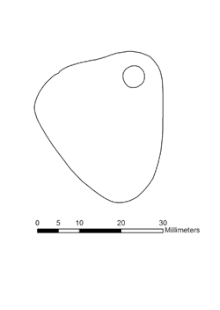Star Carr Pendant
The Star Carr Pendant is a unique engraved shale pendant from the Mesolithic site of Star Carr in North Yorkshire. It has been described as the oldest Mesolithic art in Britain.[1]
| Star Carr Pendant | |
|---|---|
 Star Carr Engraved Pendant | |
| Material | Shale |
| Discovered | 2015 Star Carr, North Yorkshire 54°12′51″N 00°25′24″W |
| Discovered by | University of York |
| Present location | Yorkshire Museum |
Discovery
The pendant was found in 2015 by a team from the University of York during excavations led by Nicky Milner.[2] It was excavated by Tom Bell, a student from the University of Chester on the last days of the excavation.[3] It was found in a context from the edge of the palaeolake Lake Flixton.
Description
The pendant is sub-triangular in shape and measures 31 mm x 35 mm x 3 mm. ED-XRF (energy-dispersive X-ray fluorescence) was used to prove that it is made from shale. The front face is engraved with a series of parallel, incised lines which often cross each other. It has a perforation, made by drilling through from the engraved side at one of the lobes.[2]
On the reverse side to the engraving there is a nick caused by a missing flake of shale in the central region. This may have happened accidentally or intentionally, presumably by something hard striking this surface before it was deposited in the lake.[2]
Significance
The pendant is unique and is the earliest example of Mesolithic art in Britain. Whilst it is very similar to a number of other pendants from northern European sites, this pendant is unique as it is made from shale, whereas the other examples tend to be crafted from amber. It is also one of the few decorated pendants that have been found within an archaeological context and not as a stray find. Analysis by the research team suggest that there are two phases of markings on the pendant, and that it is possible that more than one person added to it over time. Different interpretations from those who have seen the engravings have suggested that it may represent a tree, a map, a leaf, tally marks, even a representation of the wooden platforms which have been found at Star Carr.[2][4]
Public display
The pendant is now in the Yorkshire Museum[5] and first went on public display in February 2016.[6]
References
- "11,000 year old pendant is earliest known Mesolithic art in Britain". University of York. 25 February 2016. Retrieved 16 February 2018.
- Milner, N; Bamforth, M; Beale, G; Carty, J; Chatzipanagis, K; Croft, S; Conneller, C; Elliot, B; Fitton, L; Knight, B; Kröger, R; Little, A; Needham, A; Robson, H; Rowley, C; Taylor, B (2016). "A Unique Engraved Shale Pendant from the Site of Star Carr: the oldest Mesolithic art in Britain". Internet Archaeology (40). doi:10.11141/ia.40.8.
- Miller, B. (17 March 2016). ""It looked pretty normal at first": Young archaeologist recalls finding 11,000-year-old pendant at Star Carr". Culture24. Retrieved 16 February 2018.
- David Keys (26 February 2016). "Stone Age Britons may have had prehistoric secret code". The Independent. Retrieved 16 February 2018.
- "Star Carr Pendant". York Museums Trust. Retrieved 16 February 2018.
- "Yorkshire Stone Age pendant goes on display". BBC News Online. 26 February 2016. Retrieved 16 February 2018.